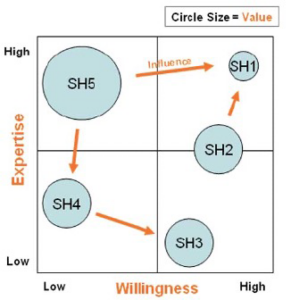 Often, we arrive at a business idea and approach and decide: This will be our business, our mission, our purpose. The excitement of the opportunity and our depth of knowledge encourage us to move forward with the belief that we have all the knowledge and resources internally to succeed. Often, that may not be the case, and in the rush to create, we overlook a key component: engaging those external to the organization who have valuable insight — our stakeholders. Let’s explore the value of including others outside the organization in the process of planning on the journey to succeed.
Often, we arrive at a business idea and approach and decide: This will be our business, our mission, our purpose. The excitement of the opportunity and our depth of knowledge encourage us to move forward with the belief that we have all the knowledge and resources internally to succeed. Often, that may not be the case, and in the rush to create, we overlook a key component: engaging those external to the organization who have valuable insight — our stakeholders. Let’s explore the value of including others outside the organization in the process of planning on the journey to succeed.
Stakeholders are internal or external groups that can affect, directly or indirectly, the activities and performance of an organization, or vice-versa. Stakeholders typically fall into two categories. The first would be primary stakeholders such as investors, employees, customers, suppliers, business and local communities. The second group, defined as secondary stakeholders, would be competitors, trade associations, media, labor unions, civil society organizations and NGOs, governments and policymakers.
We begin by designing an engagement strategy that not only sets the stage for what we hope to accomplish but allows for reflection on previous stakeholder engagement approaches. The key to engaging stakeholder groups in a constructive way is to begin by deciding who is important upfront, so as to not waste valuable time engaging those who offer minimal value to the work and planning. A common practice of deciding who to involve is to look at two variables: willingness to help and expertise. These variables can be plotted on a grid like in the example below along with the value identified by the organization.
Stakeholder Mapping

The grid enables the organization to visualize the key stakeholders and begin to prioritize. Stakeholder engagement helps organizations to proactively consider the needs and desires of anyone who has a vested interest in their organization, which can foster connections, trust, confidence and buy-in for the organization’s key initiatives.
Next, leadership should focus on having a clear direction on the type of data they wish to gather and the process. They will need to look at the long-term organization objectives to drive their approach/process and how those will positively Impact their organization and the markets/community it serves. The quickest path to success is ensuring the organization is meeting the needs of those it serves.
Finally, leadership should embrace community inclusion and a variety of points of view during the process. It’s not about embarking on every single idea presented but, rather, understanding and appreciating a variety of perspectives that, ultimately, lead to a successful direction and focus. Avoid allowing the brainstorming process to “wander” into areas that have minimal relevance to the topic by agreeing to “park” those ideas for future consideration.
Stakeholder management assists companies in identifying emerging trends, having a proactive approach to them, and acting with a first mover advantage toward their competition. If done well, stakeholder management builds a sense of community while promoting the organization’s brand reputation. It offers a chance to update collaborators on progress while having a positive impact on the bottom line. Effective stakeholder management gives companies the social license to operate, expand and innovate!
 Bruce Weber is founder and president/CEO at Weber Group. Weber brings more than 20 years of experience to the for-profit and nonprofit community, working with startup, growth and mature organizations. His focus is in strengthening organizations through strategic planning, organizational development, leadership and board development. He is a BoardSource Certified Governance trainer and a founding partner of the Nonprofit Lifecycles Institute.
Bruce Weber is founder and president/CEO at Weber Group. Weber brings more than 20 years of experience to the for-profit and nonprofit community, working with startup, growth and mature organizations. His focus is in strengthening organizations through strategic planning, organizational development, leadership and board development. He is a BoardSource Certified Governance trainer and a founding partner of the Nonprofit Lifecycles Institute.

















